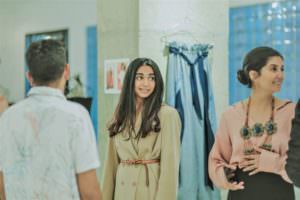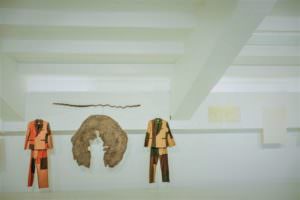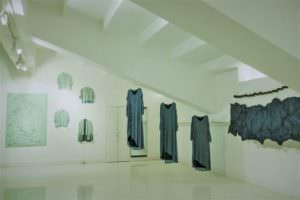Launching their first edition of a joint creative collective Est Form in Mumbai, the duo presented an exhibition of cross-disciplinary works combining textiles, painting, sculptural installations, and a selection of exclusive curated pieces of fashion. Where Art from the walls stepped down into creative wearable fashion.
Excerpts of my interview with Oona D’Mello and Sohni Patel.

Ethel: Fashion as Art, what leads to this transcendence when fashion becomes immortal?
Oona: Fashion is an artistic process. It serves for beauty and play. Art in its very essence, is made for no one else other that the deep desire to express. The makers of art and the intent with which a creative creates is what transcends an artistic process to the creation of something immortal. As a visual artist, my purpose is to express authentically and intentionally. My work is successful when it is created in its purest form as real self-expression and is capable of engaging its audience through visual storytelling, “When I make, I am the only judge. My purest thoughts lay on a canvas as color and form. Some of it is familiar, while some is internal and undiscovered. All stems from me, its source.”
Est. Form: Edition I Art X Fashion has been able to create pure art from a collaboration of visual art and design through its ‘wearable art’ line. These pieces are free of constraints of definitions. Is it art or is it fashion? Wearable art is an attempt to shift the dialogue around art being consumed from a distance, on a pristine wall, an expression of someone else that remains and forever belongs to its maker. Here, we can take art off the wall and put it on our backs, wear and adorn it; where its identity begins to engage with the identity of the one who wears it. In my opinion, the concept is immortal. The ‘Peacock’ dress, ‘Allies’ jacket or ‘Pink Seed’ corset top and skirt remain eternal, they are artworks that supersede definitions of creativity and exist outside of its silos. “Here art can live off the wall. It has been gently curated to exist in personal and private spaces through unspoken expression and storytelling.”

Ethel: What was the thought process of this exhibition?
Oona: The thought process of this exhibition is to present to the world a concept that is vulnerable, brave and necessary part of the process. Making and the interpersonal workings of art and fashion is the process of creating. However, sometimes these stories are abstract plays of color and form. Exhibiting one’s work is particularly critical to share and to invite creatives in multiple arrays of disciples to witness the enmeshment of art x fashion to a degree where it takes on a life of its own, where it is alive and no longer exists in the individual realms of art x fashion, rather collectively as a shared entity. The thought process was to generate original ideas and processes, in particular a ‘response’ process. This was where House of Sohn and I employed non-verbal communication a means of responding to each other. I would create a work of art and HoS would respond to it with a garment – in this play we were able to ensure that we didn’t miss the things that are sometimes lost in the spoken and written word.
As a visual artist, this exhibit has brought in something of deep value to my practice. I have had the opportunity to influence, and inspire a co-creative process – take my work into new landscapes and people-scapes.

Ethel: In an era of fast fashion, how do you see your contribution adding value to what you do?
Oona: This work exists outside of fast fashion. In fact, it sits outside of making or creating quickly, connecting fleetingly and moving on. Its contribution is to engage viewers of these two disciplines (art & fashion) and welcome intentionality into our day-to-day existence. Art is not fast, so when we speak of immersing two creatives together – they must absorb all aspects of the other. This gives the creation its own identity and place in the world. “When the uncommon interact, the works sees us, rather than us viewing the work.”
Sohni: In an era of fast fashion, we urge people to slow down for a moment. We live in a space of contemplation, listening and responding, and patiently co-creating – the antithesis of fleeting fashion. The process is as important as the product, because the conversations, spoken or unspoken, that happen during the process affect the energy of what is created. The culmination of the collaboration asks much more of a community than to simply buy. It asks people to think, to communicate and be apart of a greater cultural dialogue about breaking down the walls that make it challenging for distinct art forms to merge.

Ethel: What is the collaborative synergy that makes both of you a team?
Oona: The spirit and energy of collaboration is what sets a successful tone, and not a collaboration itself. The difference lies between the definition of something and the experience of it. My collaboration with House of Sohn and what defines us as a team is curiosity and the wilfulness to experiment. Our creations are a direct result of asking questions, building a deep interpersonal space of trust and appreciation for the others practice and pushing boundaries on where a medium starts and ends – there are no such lines in Est. Form.
Sohni: Curiosity was a catalyst, and from there, respect and trust were a vital part of this collaboration. We were curious, as makers and artists, about a relatively untouched creative realm where the lines between two mediums could be blurred. Respect in each other’s work as well as trust that together we could create something that would transcend any one person were imperative in turning that curiosity into an intentional process. We co-created in a response state where we had to adapt, sometimes feel discomfort, but ultimately learn to create selflessly and in true synergy.
Ethel: Does India have way too many fashion weeks, and does it aid or trivialize from the goal of growth and structure of the industry?
Sohni: This country is deeply steeped in the history of fabric, weaving techniques, embellishment art forms, and countless other traditions in the realm of fashion.
Who’s to say how a country grows or gains a sense of authority when it comes to structured fashion platforms? Maybe the many current platforms have emerged out of a country’s need to express, so much unseen craft and stifled art. Maybe one week is not enough for the techniques that have gone under the radar for so long that are being explored and contemporized to make more palatable for a modern audience. I think everything needs to be seen for people to appreciate what is genuine, what is a true expression and ultimately, what has earned the spotlight to represent a country in the world of fashion.
For collaborations, fashion reviews, travel, hospitality, launches and content, Contact email: etheldacosta@gmail.com / Work cell: 9822121012




We are a gaggle of volunteers and opening a new scheme in our community.
Your web site provided us with valuable info to work
on. You have performed an impressive activity and our whole group will likely be thankful to you.